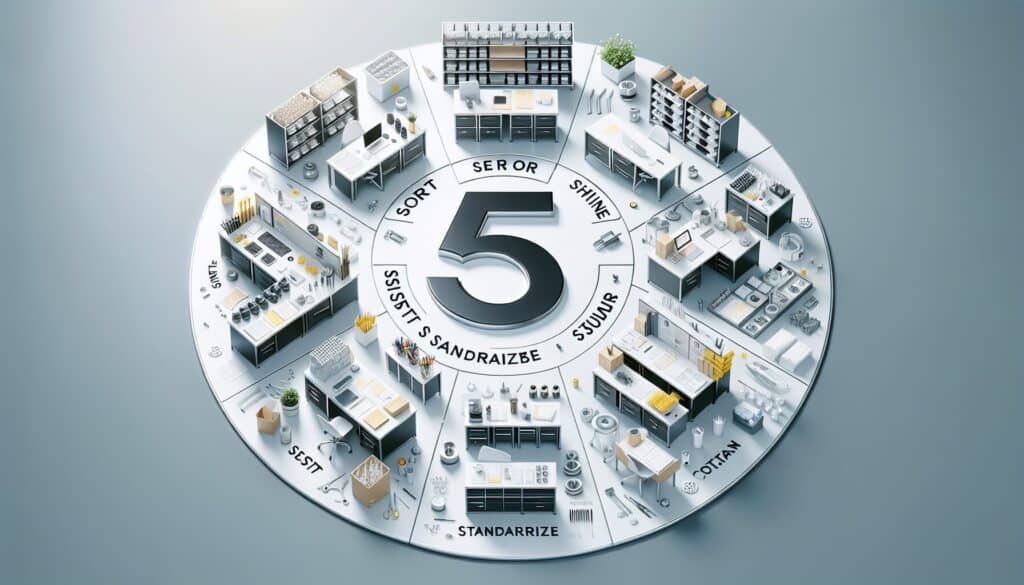A workplace organization method based on five Japanese words: Seiri (Sort), Seiton (Set in Order), Seiso (Shine), Seiketsu (Standardize), and Shitsuke (Sustain), aiming to create a clean, organized, and efficient work environment.
- Méthodologies : Ergonomie
5S

5S
- Méthodologie 5S, Amélioration continue, Efficacité, Production allégée, Amélioration des processus, Productivité, Gestion de la qualité, Safety, Réduction des déchets
Objectif :
Comment il est utilisé :
- SORT: Remove unnecessary items. SET IN ORDER: Arrange necessary items for easy access. SHINE: Clean the workplace. STANDARDIZE: Implement standards for the first three S's. SUSTAIN: Maintain the standards through discipline and continuous improvement.
Avantages
- Improves safety, quality, and efficiency; Reduces waste (e.g., wasted motion, search time); Creates a more pleasant and productive work environment; Simple to understand and implement with team involvement.
Inconvénients
- Requires ongoing effort and discipline to sustain (Shitsuke is the hardest); Benefits may not be immediately quantifiable in financial terms; Can face resistance if perceived as just a housekeeping exercise without understanding the deeper benefits.
Catégories :
- Ergonomie, Lean Sigma, Fabrication, Gestion de projet, Qualité
Idéal pour :
- Creating and maintaining an organized, clean, safe, and efficient workplace to improve productivity and reduce waste.
Le 5S methodology finds its application across various industries such as manufacturing, healthcare, and offices, effectively integrating into lean production processes. During the initial project phase, teams engage in triage through existing inventory and eliminating any tools or materials that do not contribute value, a task often initiated by team leaders or management. The next phase focuses on “Set in Order,” where items essential for daily operations are strategically organized based on their frequency of use, enhancing accessibility and minimizing time wasted searching for equipment. “Shine” encourages regular cleaning schedules that not only enhance the aesthetic appeal but also proactively identify maintenance issues that could disrupt operations. Following that, the “Standardize” phase develops specific procedures and guidelines to ensure that the practices established in the first three S’s are acknowledged and adhered to by all staff. The final phase, “Sustain,” emphasizes the importance of continuous training and periodic audits to reinforce these practices among employees, fostering a culture of accountability and improvement. Organizations implementing 5S often experience a marked increase in safety since clutter and disorganization can lead to accidents, while the enhanced orderliness supports superior quality control and operational efficiencies. Active participation from all levels of staff is encouraged, as collective engagement increases the sense of ownership and motivation, leading to sustained improvements in a tidy, well-organized environment.
Principales étapes de cette méthodologie
- Remove unnecessary items from the workspace.
- Arrange necessary items for easy access and visibility.
- Clean the workspace regularly to maintain hygiene and order.
- Implement and document standards for maintaining organization and cleanliness.
- Maintain discipline to adhere to standards and encourage continuous improvement.
Conseils de pro
- Conduct regular audits using a cross-functional team to identify areas for improvement and reinforce adherence to the 5S methodology.
- Utilize visual management techniques like codage couleur and signage to enhance the visibility of tools and resources, facilitating quick access and minimizing search time.
- Establish a feedback loop with team members for continuous improvement, encouraging suggestions and lessons learned to refine and sustain 5S practices.
Lire et comparer plusieurs méthodologies, nous recommandons le
> Référentiel méthodologique étendu <
ainsi que plus de 400 autres méthodologies.
Vos commentaires sur cette méthodologie ou des informations supplémentaires sont les bienvenus sur le site web de la Commission européenne. section des commentaires ci-dessous ↓ , ainsi que toute idée ou lien en rapport avec l'ingénierie.
Contexte historique
1960
1980
1983
1990
1995
2000
2010
1950
1980
1980
1986
1994
1995
2000
(si la date est inconnue ou n'est pas pertinente, par exemple "mécanique des fluides", une estimation arrondie de son émergence notable est fournie)














Articles Similaires
Calculateur de METS en calories
Méta-analyse
Cartographie des messages
Diagrammes du modèle mental
Forces de poussée et de traction maximales acceptables
Planification des besoins en matériaux (MRP)